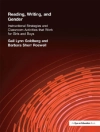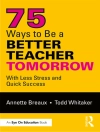Your blueprint for skilled Common Core literacy alignment!
Learn to artfully navigate Common Core – or any state/province – standards with concrete, step-by-step instruction from master teacher and curriculum specialist, Kathy Tuchman Glass. Confidently map a unit of study aligned to Common Core’s rigorous, evidence-based writing and reading requirements. Dive into in-depth analyses of informational text with supporting essential questions. Glass walks you through the entire process with manageable chunks that eliminate overwhelm.
Chapters include thorough explanations, step-by-step exercises, and detailed templates, assessments, charts, tips, and prompts centered around key CCCS concepts for grades 6–12.
Teachers, curriculum committees, grade level teams, and professional development leaders will learn to:
- Challenge and engage students in all content areas using the CCCS ELA framework
- Use existing curriculum and materials to design new, CCCS-aligned units of study
- Identify mandatory CCCS ELA essential understandings for informational text, evidence-based writing and other critical competencies
- Conduct resource-rich workshops and professional development
This all-in-one instructional guide, with a companion website for extra help, improves your professional capacity to create, revise, or critique quality-driven units and lessons aligned to the ELA Common Core. Get this essential blueprint to building high quality 6–12 grade-level curriculum for skilled CCCS literacy-aligned success!
‘Like them or hate them, the Common Core Standards represent one of the most significant opportunities for improvement schools have faced in decades. This book will be a great help to anyone engaged in the act of translating the Common Core into actual teaching practices.’
–Jim Knight, Author of High-Impact Instruction
Tabella dei contenuti
List of Figures
Foreword
Acknowledgments
About the Author
Introduction
Chapter 1: Standards and Knowledge
The Purpose of Standards
Key Areas of Emphasis in the ELA Common Core Standards
Understanding Fiction and Nonfiction Characteristics
Definitions of the Common Core Text Types and Sample Prompts
What Do Argument Texts Entail?
What Do Informative/Explanatory Texts Entail?
What Do Narrative Texts Entail?
A Closer Look at Appendix C: Samples of Student Writing
Identifying and Articulating the Language Standards Across Grades
Exercise 1: What Is the Best Way to Group Standards?
Unit Focus and Template
Considerations for Grouping Standards
Grouping Standards: Two Approaches
Definition and Examples for Knowledge
Exercise 2: How Are Standards Used to Determine What Students Should Know?
Looking Ahead
Chapter 2: Essential Understandings
The Nature and Critical Importance of Essential (or Enduring) Understandings
Essential Understandings as Statements of Conceptual Intent
Examples of Essential Understandings Aligned to the Anchor Standards for Reading
Special Considerations: Time, Intellectual Growth, Clustering
Constructing Your Own Essential Understandings
Exercise 3: How Do Educators Create (or Revise) Essential Understandings?
Sharing Essential Understandings With Your Students
Looking Ahead
Chapter 3: Guiding Questions
The Importance of Guiding Questions
Sharing Guiding Questions With Your Students
The Differences Between Essential Unit and Lesson Guiding Questions
Designing Text-Dependent Questions for Complex Text
How Do Teachers Facilitate Close Reading of Complex Texts?
Examples of Essential Unit and Lesson Guiding Questions for Grammar and Conventions
Constructing Your Own Essential Unit and Lesson Guiding Questions
Exercise 4: How Do Educators Create (or Revise) Essential Unit and Lesson Guiding Questions?
Looking Ahead
Chapter 4: Unit Map Template and Example
Customizing and Adapting the Unit Map to Fit Your Needs
Organizing Unit Maps and Student Work
Looking Ahead
Chapter 5: Summative Assessments and Preassessments
Types of Assessments
Summative (Culminating) Assessments
Rubrics
Checklists
Preassessments
Constructing Your Own Summative Assessment
Exercise 5: How Do Educators Determine an Appropriate Summative Assessment?
Looking Ahead
Chapter 6: Skills, Activities, Formative Assessments, and Resources
Skills
Teaching Strategies and Learning Activities
Formative Assessments
Resources
Identifying Skills and Constructing Activities, Evidence of Assessment, and Resources for Your Targeted Unit
Exercise 6: What Targeted Skills With Associated Activities, Evidence of Assessment, and Resources Can Educators Design (and Find) for a Targeted Unit?
Looking Ahead
Chapter 7: Differentiated Instruction
Content, Process, and Product
Readiness, Learning Profile, and Interest
Instructional Strategy: Rolling Dice or Cubes
Instructional Strategy: Using Manipulatives
Constructing Your Own Differentiated Instructional Strategies
Exercise 7: How Can You Indicate Differentiation on Your Unit Map?
Looking Ahead
Chapter 8: Lesson Design
Lesson Components
Sample Lessons
Next Steps After Designing Lessons
A Final Note
Lesson 1: What Are Inferences? How Do I Make Inferences About This Text?
Lesson 2: What Is Characterization? How Do Authors Use Characterization to Create and Develop Characters?
Lesson 3: What Factors Help Me to Evaluate the Credibility of Sources?
Lesson 4: What Are Elements of an Argument Paper? What Are the Expectations for My Finished Argument?
Resource: A Brief Primer on the ELA Common Core Standards
Creation and Purpose of the Common Core Standards
Who Led the Standards Initiative, and What Is the Goal?
Who Are the CCSSO and NGA?
Content and Structure of the Common Core Standards
Research Highlights for the Reading Strand
Logistics
Can States Add to the Standards?
How Can Standards Be Identified?
Collaboration, Limitations, and Assessment
Who Uses These Standards Besides the ELA Teacher?
What Aspects Are Not Covered in the Common Core Standards Document?
What to Look for When Aligning Existing Standards With the Common Core
Assessments
Closing
References
Index
Circa l’autore
Consulting Description Kathy Glass is a former teacher who consults and presents nationally with K-12 teachers and administrators at schools, districts, conferences, and county offices of education. She offers a blend of professional development (PD) topics to target audiences in areas affecting curriculum and instruction. To deliver customized PD, she assists educators with strategic planning to determine objectives. Then she tailors PD based on requested topics such as, but not limited to: · highlights of the ELA Common Core Standards· implementation of the ELA Common Core or other standards-based curriculum using a backward design approach· essential understandings and guiding questions to frame curriculum and instruction· differentiated tools and instructional strategies · pre-, formative, summative, and self-assessments · alignment of six-traits writing instruction and assessment to curriculum goals· unit and yearlong curriculum maps· text-dependent questions to facilitate close reading, and more. To help educators directly translate what she presents into effective classroom practice that impacts students, Kathy can provide a variety of PD opportunities (e.g., presentations, lesson demonstrations and modeling, coaching, collaborative unit design, etc.). She is the author of six books: Mapping Comprehensive Units to the English Language (ELA) Arts Common Core Standards, 6-12 (May, 2013); Mapping Comprehensive Units to the ELA Common Core Standards, K-5 (© 2012); Lesson Design for Differentiated Instruction, Grades 4-9 (©2009); Staff Development Guide for the Parallel Curriculum (©2009); Curriculum Mapping: A Step-by-Step Guide to Creating Curriculum Year Overviews (©2007); and Curriculum Design for Writing Instruction: Creating Standards-Based Lesson Plans and Rubrics (©2005). In addition, Glass has served as a reader and reviewer for Reader’s Handbook: A Student Guide for Reading and Learning (2002, Great Source Education Group) and as a contributing writer and consultant for the Heath Middle Level Literature series (1995, DC Heath and Co). Website: www.kathyglassconsulting.com; email: [email protected]












